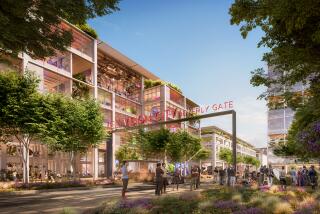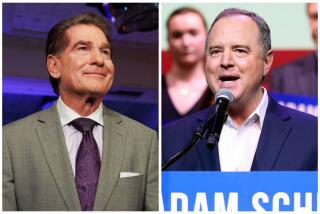Felvey Tied to Trade Center in Santa Ana
- Share via
POMONA — H. Thomas Felvey, whose four-year effort to build a $96-million world trade center in downtown Pomona died earlier this year after he was unable to secure commitments from investors and tenants, has worked recently on a similar project in Santa Ana.
Felvey, whose legal and financial problems eventually caused Pomona city officials to view his role with increasing skepticism, worked as an unpaid consultant with the World Trade Assn. of Orange County. That group hopes to build a $100-million complex devoted to international trade activities in downtown Santa Ana.
But whereas the Pomona project was conceived and promoted largely by Felvey, the Santa Ana trade center has been envisioned by business leaders in Orange County for more than a decade.
Trail of Debts
And although Felvey has played a critical role in putting together a project team to develop the Santa Ana complex, his participation in the venture has been carefully charted by the trade group that is organizing the effort.
The Orange County group’s caution stemmed from the publication of information about the business dealings of Felvey, whose past includes a trail of debts, tax liens and unfinished projects.
Since 1977, he has failed to answer 18 lawsuits filed against him and three of his corporations. A number of former business associates claim in the suits that he walked out on deals and left them unpaid.
Those suits resulted in default judgments totaling more than $270,000, but some plaintiffs said they doubt they’ll ever collect what’s due them. At least two other lawsuits against him are pending.
‘Talking to Everybody’
Reached at his office in Laguna Niguel, Felvey, 42, would not comment on his past or on the Pomona project, his first major undertaking as a developer. He also refused to acknowledge that his current company is called Urban Equities, the name he used with Santa Ana officials and the World Trade Center Assn. of Orange County.
He did say that he believed the Pomona project was still viable and that he has been “talking to everybody” about trying to get it done--even though the city has ended its exclusive arrangement with him to develop it.
He also minimized his role with the Orange County group.
“I only worked for about four months as a consultant, and I didn’t take any payment because I want to further the cause,” he said. “I’m a volunteer to the association. I have no further role in this project. My job’s done.”
Felvey said he gave the group “some ideas” on getting a trade center built. But others say his role was much more involved.
‘Done a Very Good Job’
“Tom’s done everything he said he was going to do, and he’s done a very good job,” said Susan T. Lentz, executive director of the association. “We wouldn’t have got as far as we have without him. He has been the spark.”
The staff at the Santa Ana Redevelopment Agency, which is seeking bids to develop the acre parcel, consider him as the prime mover behind the filing of a statement of qualifications outlining a team of well-known builders and developers ready to put up a trade center.
“It’s his submission,” Josephine La Quay, an agency project manager, said about the filing.
Richard J. Schwarzstein, a Newport Beach lawyer who co-founded the association 12 years ago, said Felvey is “very knowledgeable about the world trade center concept” and helped the association by putting the development team together.
“He wasn’t going to be the developer for us anyhow,” Schwarzstein said, “so it was a pleasure to work with him.”
Association members had read all the stories printed about Felvey, Lentz said.
Others Less Charitable
“That’s why the agreement (to have him act only as a consultant) was predicated the way it was,” she said.
Whatever measure of redemption Felvey has gained for his work in Santa Ana, others who have crossed his path are less charitable.
Robert Clayton, whose economic consulting firm, R & R Clayton Inc., worked on two of Felvey’s projects including the Pomona World Trade Center, said people should be cautious about retaining Felvey to work on a major project, including the trade center in Santa Ana.
“Mr. Felvey’s involvement is like starting the project with a huge iron ball chained around your neck,” Clayton said. “Mr. Felvey’s credibility in the financial world is very slim. A . . . number of people in Southern California have the skills to develop a project of that nature. . . . Mr. Felvey would be the last person I’d look for.”
Good First Impression
Clayton said Felvey is best suited to be a promoter, the role he played early on in the Pomona trade center project.
“I think he makes a very good initial impression,” Clayton said. “I think that in the case of Pomona, for example, he was able to appear credible to the city. He has a friendly sort of outgoing manner that seems to work well. But when it got to the nitty-gritty of negotiations, he didn’t seem to understand a lot of the details.
Pomona Mayor Donna Smith offered a similar, but more positive, assessment of Felvey.
“I would say that he’s good at telling stories and trying to make those stories come true,” Smith said. “Mr. Felvey was a little ambitious, and he did get ahead of everyone a few times. . . . (But) I can’t put all the blame (for the Pomona project’s failure) on Mr. Felvey. I wish him a lot of luck. Maybe a consultant’s position would be better for him.”
Seeking Default Judgment
Clayton is seeking a default judgment in his suit for $22,000 in unpaid fees against Felvey. But Clayton’s lawyer, Timothy White of Costa Mesa, said: “I don’t expect that we’ll ever collect any money from him.”
Another unsatisfied litigant is Paul Singer Flooring of Sherman Oaks, which received a default judgment in 1985 for $17,000 in unpaid bills against one of Felvey’s former firms, Corporate Planning & Research Inc.
“We haven’t gotten a quarter,” said Roger Licht, attorney for the flooring company. “He’s sworn under penalty of perjury that he had no assets of any kind.”
Felvey’s prior work has involved mainly interior design work on restoration projects, former associates said. He also worked in New York for the Chicago architectural firm of Skidmore, Owings & Merrill, a firm he has brought in to the Santa Ana World Trade Center project.
Exclusive Agreement
He has had several successful projects to his credit, but he had never tackled anything of the magnitude of Pomona’s World Trade Center when he got involved in its planning in 1984.
Within a year, he signed an exclusive agreement with the city to develop a $96-million project that would include a 12-story office building, a 260-room hotel with convention facilities, museums, theaters and 50 retail stores and restaurants on 4.6 acres across the street from Pomona City Hall.
In April, 1987, the City Council voted to issue $100 million in revenue bonds to finance construction. But council members soon learned of Felvey’s numerous lawsuits and insisted that he find a reputable development partner.
The partner was to be Birtcher Construction. But the Laguna Niguel firm backed out of the deal, telling the city last November that the project was “too ambitious and complex.”
Occasional Contact
Pomona officials said Felvey contacted them only occasionally after information about his legal problems surfaced.
They said they last heard from him on April 29, when they received a telex from him requesting a four-month extension of a May 1 deadline to line up security for the bonds and commitment from tenants for the complex. The city decided to let the deadline pass and to end the exclusive relationship with Felvey.
Pomona City Administrator A. J. Wilson, who oversaw several redevelopment projects in Santa Ana as city manager there between 1980 and 1983, said the Pomona trade center proposal failed because Felvey’s proposal to build an elaborate 12-story office-hotel complex was not economically feasible.
With vacant land cheap and plentiful in the area, demand for office space was not sufficient to support such a costly project, Wilson said. That factor, not Felvey’s reputation, was the reason for the proposal’s demise, Wilson said.
Driving Force
“I don’t know that Tom Felvey has a bad reputation in the business community,” Wilson said. “I can’t say that any tenant ever turned their back on the project because of Mr. Felvey’s involvement. . . . It doesn’t matter if (the person behind a project is) Tom Felvey or Donald Trump. Economics is what drives development.”
Clayton said the Pomona trade center proposal was originally conceived as a much smaller and economically sound project than the one Felvey presented to city officials. However, Felvey revised the project, increasing its overall size by 40% and tripling the amount of area that would not produce revenue, Clayton said.
“The project kept getting bigger and bigger,” Clatyon said. “I think (Felvey) was trying to make his fortune on one project, and a developer who’s worth his salt doesn’t do that. You end up developing a project that’s out of line with market demand.”
Center Possible
However, Smith said she believes a world trade center in Pomona is possible. Taiwanese investor Harvard Fang, who first became interested in the trade center proposal after he was contacted by Felvey, is still interested in the idea, she said.
With the expiration of Felvey’s agreement with the city, Smith said the city can entertain other offers.
“We were very happy to see the agreement die, which meant we were no longer dealing with Mr. Felvey,” Smith said. “We are happy that Mr. Felvey is no longer involved in this project or with any project in the city of Pomona.”
More to Read
Inside the business of entertainment
The Wide Shot brings you news, analysis and insights on everything from streaming wars to production — and what it all means for the future.
You may occasionally receive promotional content from the Los Angeles Times.










